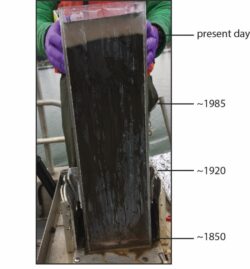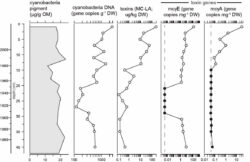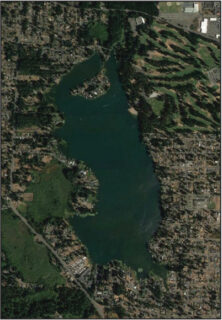by Will Hobbs, Washington State Department of Ecology

Figure 1: Photo of the 40cm sediment core collected from Spanaway Lake and the approximate ages of the sediment.
The sediments that deposit on the bottom of lakes contain information about past lake conditions and changes in lake water quality. In general, lake sediments are reliably layered year after year. To obtain information about the lake, we can sample those layers intact and establish the approximate age of each sediment layer (Figure 1). Once the sediment is dated, we can analyze the sediments for other biochemical and geochemical remains to get a picture of past lake water quality and biological activity.
Spanaway Lake is located in western Washington in the Clover-Chambers Creek Watershed. It is an urban lake with a long history of shoreline development and recreation (Figure 2). The lake also has a history of summer cyanobacteria blooms that have resulted in concentrations of the toxin microcystin above the state recreational guidelines. Microcystin is one of the most common toxins found in Washington lakes that are impacted by cyanobacteria blooms. Total microcystin (the substance we measure) is actually a combination of over 200 compounds, although seven compounds commonly comprise the bulk of the total microcystin in lake water. Using the lake sediment, the goals of our work on Spanaway Lake were to 1) decipher whether cyanobacteria have been part of the algal communities for the last 150 years (i.e., before lake shoreline settlement), and 2) if cyanobacteria were present historically, determine whether microcystin compounds were being produced.

Figure 3: Plots of the cyanobacteria pigment and DNA measurements in the sediment and plots of the toxin (microcystin) and toxin-producing genes in the sediment.
We used two independent markers of past algal production to establish that cyanobacteria have long been present in Spanaway Lake. First, the biochemical remains (the pigmentation in the algal cells) were extracted from individual sediment layers to evaluate the presence and amount of certain types of algae over time. Second, DNA remains were extracted from the sediment layers and DNA sequences specific to cyanobacteria were identified. The pigment remains in the sediment suggest that cyanobacteria have been present in the lake since around 1850 (Figure 3). It also appears that other types of algae, such as diatoms, were more prevalent historically. The DNA remains confirm that cyanobacteria were present since around 1850.
To establish whether the toxin microcystin has been produced by cyanobacteria since ~1850, we were able to analyze the individual sediment layers for certain microcystin compounds and look for the presence of the cyanobacteria genes that produce microcystin. The main microcystin compound found in Spanaway Lake (MC-LA) was measured in the sediment layers deposited around 1850, confirming that the cyanobacteria were producing toxins historically (Figure 3). In addition, two genes responsible for the production of microcystin (mcyE and mcyA) were also measured in sediments, back to ~1850 in the case of mcyE.
In addition to establishing that cyanobacteria have long been a part of the algal communities of Spanaway Lake, our work also suggests that since 1985 there have been higher levels of toxin production and a dominance of cyanobacteria over other types of algae. A more comprehensive discussion of this work can be found in a recent Washington State Department of Ecology publication called The Historical Prevalence of Cyanobacteria in Spanaway Lake, Pierce County, WA.










